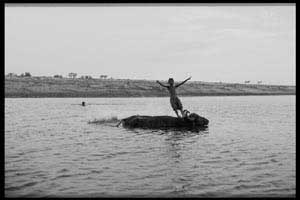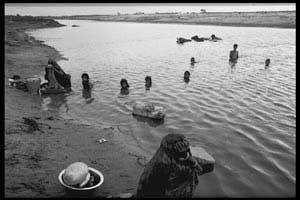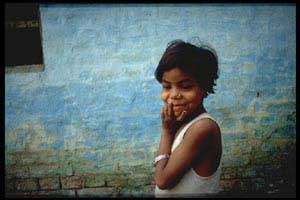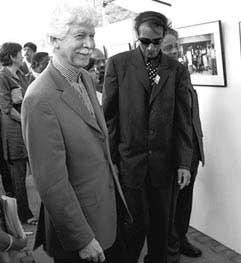Magazine
Atman's Atma

A Mauritian's search for his Indian roots.
|
Born in Mauritius, educated in Paris and California and settled in the Netherlands. Atman Ramchalaon, fluent in five European languages, is truly a citizen of the world. But even a self-confessed world citizen at some point in time feels the need to root himself to one place. And this yearning to trace his roots took Atman, a hotshot photojournalist and film-maker who has followed the action from the Falklands War, Gulf War I, the Gujarat quake to Gulf War II – to the windswept, hot and humid plains of Eastern India.
Back in Amsterdam after a month’s sojourn in India, Atman speaks wistfully of his soul-searching journey, “At least now my mother can die in peace.” However, the task he had assigned to himself was by no means simple. The last two years that he spent contacting people and officials were harrowing, to say the least. An email message floated by Atman on the Net paraphrases his agony: “My mother is 85 years old. Her last wish before she dies is to know her roots. The registry of Indian immigrants at the MGI/Mauritius Archives belongs to all of us. It should be free and accessible to the public. I am requesting ANYONE, also on behalf of my mother to help me fulfil her last wish. Let me have the access code so that I can check for info on my ancestors online.” With the Government officials of little help, Atman had to rely totally on the help offered by faceless strangers. It proved to be an exasperating experience. One such incident exemplifies this frustration: An official in the Uttar Pradesh State Archives when approached, asked Atman to furnish all the details, something Atman himself was looking for. Atman’s obvious reply was, “If I knew I wouldn’t be asking you!” During that dark period of information drought, Atman plastered the various interactive Indian newsletter groups as varied as the Bhojpuri (dialect) group and the Nagpur City group with messages. A stranger responded saying he knew about the villages mentioned by Atman and that he would do his utmost to help him.Within seconds of receiving the email, Atman called his mother in Mauritius. Tears of joy welled up in her eyes. Says Atman, thanks to this man, I could see my mother’s dream coming true at long last.
Soon more people reached out to him and Atman started following the leads on village Anjorpur (in Ballia district of Uttar Pradesh) where his great grandmother Laxminia Kokil, who migrated to Mauritius around 1896, was born and brought up. Once the coordinates were ascertained, Atman began searching for documented evidence t from the local registrar of births and deaths in Ballia and for the list of indentured labour in Mauritius and India. He drew a blank on several occasions, but undeterred, he persisted. Eventually as things began falling in place, Atman decided to take a trip to his land of ancestors. He was able to trace some of his family members, both near and distant, and true to his calling, lost no time in capturing them on camera. He also clicked for eternity, the “landscape” on which his grandmother was brought up. While he was shooting, the villagers started complaining about how their “Masooms,” their innocent children, were whisked away to Mauritius. “The British not only took away our sons, husbands and brothers but also our children and exploited them to the hilt for their vested interest.” While the grownups knew what the British were up to, the children or the Masooms (often unaccompanied by their parents) had no idea where they were being taken. They were locked in sub-depots in Chapra (Bihar) and “transported” to a larger depot in Kolkata (Calcutta), from where they were “shipped” to Kala-pani. This brought back a flood of memories for Atman. “My mother remembers my grandfather Ramessar looking into her eyes while cradling her and saying, ‘Tor ankhwa Bharat ke masoom laika ke tarah ba,’ meaning you have got the same innocent look like those children who came from India.” While Atman was researching the archives of indentured Indians in Mauritius, Guyana, Suriname and South Africa, he came across names of many children from former British colonies registered as indentured immigrants. He says: “That very moment I decided that whenever I would travel to the land of my ancestors, I’d shoot a photo-serial and capture this look of innocence and freeze it for posterity.” A selection of these photos of “Masooms” were showcased in Agfa, Germany and an exhibition of indentured immigrants was held in Maurituius last year.
Atman’s maternal great grandfather was 14 when he was taken for some “light labour” to “the land of milk and honey” (Mauritius) on an arbitrary 8-year contract. In return he was “free to eat as much as possible.” Nothing could have been further from the truth. Indentured by a sugar estate in Flacq, he was forced to work from dawn to dusk on the cane fields. When his “par-nana” reached the age of 18, the sugar estate owner forced him to marry an indentured girl of his age. Soon, Atman’s grandfather Ramessar Sobrun was born, but because of sheer overwork, his great grandfather died before he could realise his cherished dream of returning to his homeland. There were still three more years to go before the contract ended. During the quest for his roots, there were many moments of reckoning where Atman stood face-to-face with a totally unknown and hitherto uncovered facet of his family history. One of the villagers showed him an old-fangled film projector which his paternal grandfather had requisitioned to show movies to the villagers. On seeing it, Atman broke down and sobbed like a child. “This is where I must have inherited my love for film-making. It was there in my genes,” he says in a choked voice. There was also an element of surprise for the villagers who took Atman for a “videshi” brown sahib (westerni foreigner) and tried to converse with him in broken Hindi-English. They were taken aback when he talked back in fluent Bhojpuri! Atman’s India trip proved to be a journey of discovery in more ways than one. He was appalled by the condition of the archives both in Lucknow and Chapra. “The records were kept in bundles of gunnybags in Chapra. There was no index. We managed to open 25 bags to check for info on Tarrowa village (my ancestral place), unfortunately most of the records were already moth-eaten and therefore unreadable. It was raining, the roof of the collectorate building was leaking, and most of the gunnybags were wet. Some were even floating. The condition of the State Archives in Lucknow was equally bad.”
Atman’s ancestors left their homeland due to the cruel exploitation by the zamindars (landlords), besides excruciating poverty and disease. But 150 years down the line, he says nothing seems to have changed. A note in his India diary reads: “There is still no infrastructure, no running water, no electricity, no proper housing, no sanitation. There is lawlessness, corruption, violation of human rights and the zamindars are still exploiting the poor.” There were many other jarring notes too. Recalls Atman, ‘I had written to the District Magistrate of Chapra a dozen times from Amsterdam. Leave alone a reply, there was not even an acknowledge-ment. Later when I visited Chapra, I saw all my e-mails adressed to him still in the PC at the collectorate. The DM and his secretary told me they could not reply because they did not know how to use the computer!’ Shaking his head in utter disbelief, Atman adds cynically, “I guess instead of exporting its IITians abroad, India should keep them within the country.” Unfortunately, the rigors of the trip took their toll on Atman and he fell sick while searching for Tarrowa village in Chapra, forcing him to abort his journey midway, and he returned to Amsterdam. However, a rejuvenated, feisty Atman says, “This is not the end. I will be back in India to make a video-diary soon.” For, as they say, tomorrow is yet another day, especially for someone who is looking for his yesterday. |




